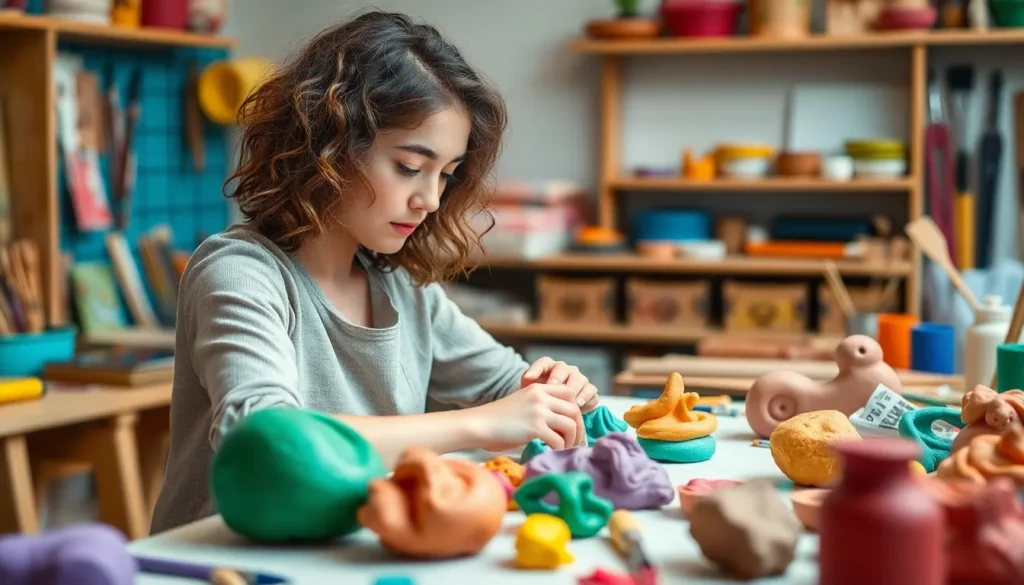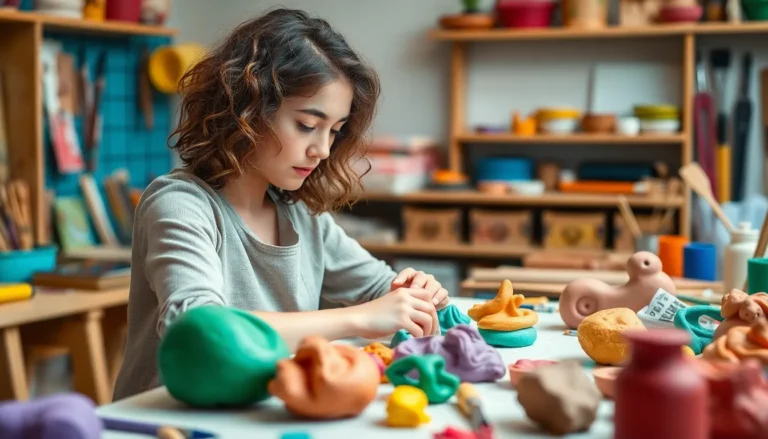Table of Contents
ToggleIn a world dominated by screens and digital distractions, tactile thinking practice offers a refreshing escape. Imagine engaging with your thoughts through touch—feeling textures, shapes, and materials as you brainstorm. It’s like giving your brain a workout while your fingers have a little fun!
Tactile thinking isn’t just for kids playing with building blocks; it’s a powerful tool for adults too. Whether you’re an artist, a problem-solver, or just someone trying to make sense of life’s chaos, this hands-on approach can spark creativity and innovation. So why not trade in your keyboard for some clay or fabric? Embrace the messiness of tactile exploration and watch your ideas come to life in ways you never thought possible. After all, who said thinking can’t be a little bit fun?
Overview of Tactile Thinking Practice
Tactile thinking practice encourages hands-on engagement with materials to stimulate creativity. This approach contrasts sharply with the digital distractions common in today’s world. Engaging tactilely—using clay, fabric, or other materials—leads to enhanced idea generation. It provides an effective outlet for both children and adults, offering a pathway to innovation.
Individuals in artistic fields benefit significantly from tactile methods. Artists often find that manipulating physical objects sparks new ideas. Problem-solvers too experience a surge in creativity when they physically interact with materials. Adults who adopt this practice open themselves to various forms of inspiration, often overlooked in purely digital processes.
The practice itself promotes exploration and experimentation. By embracing tactile thinking, individuals enhance their brainstorming sessions. Mental blocks often diminish as hands-on experiences lead to unconventional solutions. Moreover, those who engage in tactile activities report increased enjoyment in the thinking process.
In formal educational settings, tactile thinking integrates seamlessly into learning methodologies. Educators observe that students who engage with physical materials grasp concepts more readily. Tactile activities often make abstract ideas more tangible. Implementing tactile thinking into daily routines fosters a more playful approach to challenges.
Overall, tactile thinking practice stands as a powerful tool for innovation, creativity, and problem-solving. Participants discover that physical interaction with materials allows for deeper connections with their ideas. As a result, tactile practice nurtures an environment where creativity thrives.
Benefits of Tactile Thinking Practice

Tactile thinking practice offers significant advantages for creativity and cognitive development. Engaging with materials through touch enhances various skills essential for both personal and professional growth.
Enhancing Cognitive Skills
Tactile thinking stimulates brain functions, leading to improved cognitive skills. Engaging with physical materials like clay or fabric promotes neural pathways, fostering a deeper understanding of concepts. Individuals who practice tactile thinking often experience enhanced memory retention. Information becomes easier to recall when related to hands-on activities. Learning through touch solidifies abstract ideas, bridging the gap between theory and practice. Moreover, this hands-on approach encourages critical thinking, as users interact with objects and explore their properties. Individuals increase their ability to synthesize information by manipulating materials, resulting in stronger problem-solving capabilities and innovative thought processes.
Improving Problem-Solving Abilities
Tactile thinking significantly boosts problem-solving abilities by encouraging exploration and experimentation. Individuals can break down complex problems more efficiently when they physically engage with materials. Manipulating objects provides a sense of control, allowing users to visualize different solutions. Direct interaction with tangible items can lead to unexpected insights, breaking mental blocks that impede creativity. This practice nurtures flexibility in thought, as individuals adapt their strategies based on hands-on experiences. Adults and children alike benefit from this approach, finding joy in the process of discovery. Overall, tactile thinking facilitates a more innovative environment, essential for effective problem-solving.
Techniques for Implementing Tactile Thinking
Tactile thinking can effectively enhance creativity and problem-solving through various techniques.
Hands-On Activities
Engaging in hands-on activities stimulates tactile thinking. Utilizing materials like clay, fabric, or building blocks fosters exploration. These activities encourage manipulation, allowing individuals to express their ideas physically. As they create, it generates new perspectives. For instance, an art project can lead to original insights as artists mold and shape their work. Incorporating crafts or DIY projects frequently results in tangible outcomes, transforming abstract concepts into comprehensible forms.
Interactive Learning Environments
Interactive learning environments promote tactile thinking significantly. Classrooms that emphasize collaboration and hands-on exploration support meaningful learning experiences. Tools such as science kits, puzzles, or sensory bins actively engage students. Group activities where students build models or conduct experiments enhance comprehension. These processes enable participants to connect theoretical knowledge with practical application. Students experience deeper understanding through physical involvement, generating enthusiasm and curiosity for the subject matter. Adopting such environments results in better retention and a more enriching educational experience.
Tactile Thinking in Education
Tactile thinking enhances educational outcomes significantly. Educators integrate hands-on activities to make abstract concepts accessible. Through interaction with materials like clay or fabric, students engage deeply with ideas. This method facilitates understanding by linking theory to practice.
Learning environments that prioritize tactile thinking foster collaboration. Group projects involving building models or conducting experiments connect theoretical knowledge to real-world applications. Such activities empower students to explore and express their ideas through physical means.
In addition, tactile thinking boosts cognitive skills and memory retention. Engaging with materials allows students to solidify their grasp on complex subjects. Physical interaction with objects encourages critical thinking and the ability to solve problems effectively.
Interactive classroom tools such as science kits or sensory bins promote active participation. Students benefit from exploring and manipulating these materials, which heightens their comprehension. The hands-on approach nurtures creativity and reduces mental blocks, making learning enjoyable.
Furthermore, tactile thinking aids in developing flexibility in thought processes. Students learn to break down complex problems through tactile exploration. This exploration results in unexpected insights and nurtures a sense of discovery that enhances their learning journey.
Real-World Applications of Tactile Thinking
Tactile thinking finds extensive applications across various fields, enhancing creativity and problem-solving. Artists utilize tactile practices, engaging with materials like clay or fabric to explore their ideas physically. This hands-on interaction often leads to unexpected artistic breakthroughs, as manipulating objects inspires new creative directions.
In the realm of education, educators incorporate tactile thinking to improve student engagement and understanding. Classroom activities involving hands-on projects, such as building models or experimenting with scientific tools, help students make connections between theoretical concepts and real-life scenarios. These methods significantly enhance knowledge retention and foster a collaborative atmosphere among peers.
Additionally, businesses benefit from tactile thinking in brainstorming sessions. Teams engage in building prototypes, utilizing physical materials to visualize ideas and spark innovative solutions. This tactile approach can lead to novel product designs and more effective problem resolution by facilitating a more dynamic idea generation process.
Therapists also implement tactile thinking techniques within therapeutic settings to aid clients in emotional expression. Utilizing creative materials encourages individuals to externalize feelings, fostering deeper conversations during sessions. This practice not only promotes emotional awareness but also helps participants develop new coping strategies through exploration.
Overall, tactile thinking enhances cognitive capabilities across various real-world applications. Engaging with physical materials promotes creativity in artistic endeavors, facilitates comprehension in educational environments, supports innovation in business, and aids emotional processing in therapeutic settings. As a multifaceted approach, tactile thinking serves as an essential tool in diverse contexts, enriching experiences and broadening perspectives.
Tactile thinking practice offers a refreshing approach to creativity and problem-solving. By engaging physically with materials, individuals unlock new ideas and enhance cognitive skills. This hands-on method not only fosters innovation but also makes the thinking process enjoyable and approachable.
In educational settings, tactile thinking bridges the gap between theory and practice, allowing learners to grasp complex concepts more effectively. As more people discover the benefits of tactile exploration, it’s clear that this practice can transform how ideas are generated and developed across various fields. Embracing tactile thinking is a step toward a more creative and connected way of engaging with the world.







